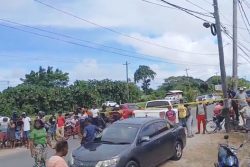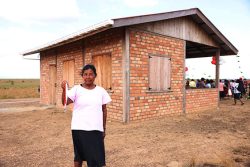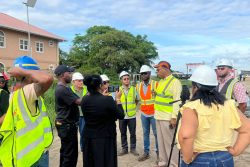The Shadehouse Vegetable Production Project, which aims to use hydroponic and natural/organic vegetable cultivation for income generation by the poor in rural and coastal communities, was officially launched yesterday.
The $1.35 million project, which is being implemented by Partners of the Americas (Guyana Chapter) and the Caribbean Self Reliance International (CASRI) and is already in its second phase, is geared at providing “sustainable livelihood opportunities for low income households, in rural and coastal communities in Guyana.”
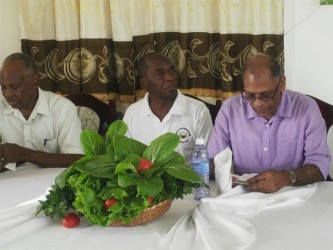
Speaking yesterday at the launch at the St Stanislaus College Farm, in Sophia, Project Manager Kelvin Craig explained that the goal is to improve the economic welfare of the vulnerable and disadvantaged, as well as to increase community economic growth.
Craig said the project, which is funded by the Inter-American Development Bank and the Japanese Trust Fund, works by providing target residents with technical training and practical support for the implementation of hydroponic and natural/organic cultivation practices on small farms and home gardens. It would also seek to increase sales and market access and facilitates the organisation of hydroponic and natural/organic vegetables by participating producers. It will also be focusing on marketing, production and record keeping.
Apart from ongoing training in hydroponic vegetable production, future project activities would also see beneficiaries supplying their communities and would include market studies and guidance in appropriate packaging for produce.
To date, over 500 persons have been trained in hydroponic/natural vegetable production and have home-based gardens in regions Two, Three, Four and Five, while 32 new shadehouses have been established in regions Three, Four, Five, Six and Seven.
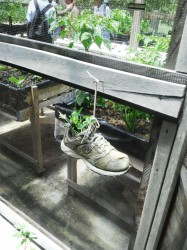
Suzy Wong, a beneficiary, urged all to take advantage of the project. She said, it is a good initiative, since hydroponic farming utilises a small space and less physical work. Juliet Munian, of Essequibo, who said she had been farming bananas for the past 30 years, said she started hydroponic farming out of a need for fresh vegetables for her family. And Gerond Roberts, Toshao of Bethany Mission on the Supenaam River, said the introduction of hydroponic farming has lit up that community. He said 25 persons have built shadehouses. “We want our community to diversify in agriculture,” Roberts said, before adding that land space is not an issue in his community. He said he started with containers but now he has expanded to boxes.
Also speaking at the launch, Minister of Agriculture Dr. Leslie Ramsammy lauded the efforts of the Partners of the Americas for including agriculture in their efforts towards creating wealth and ending poverty among the vulnerable in Guyana. He opined that in doing so the organisation may demonstrate that there is a model to end hunger by 2025, which is the Americas’ goal. “Agriculture,” he said, “will continue to be the foundation on which Guyana is built and developed upon.”
Ramsammy urged farmers not to see farming as something poor people do, but as an investment in the country’s economy, while later observing that agriculture must be developed to create wealth for the practitioners. Those are the investors that keep the economy rolling,” he said, adding that there is a place for both the large and small investors. The small hydroponic farm, shadehouses, and drip irrigation are all contributing to the development of Guyana, Dr. Ramsammy stated, while noting that the country has moved from importing large amounts of vegetables, such as cauliflower and broccoli, to producing them.
The Guyana School of Agriculture (GSA), Ramsammy also noted, has a shadehouse that practices hydroponics. He added that 100 students are graduating annually with the knowledge of the technology. They plant garlic, carrots, beets and cilantro, among other produce and he hoped to see an end to the importation of those vegetables by 2020, since Guyana has the capacity to produce them. He was also hopeful of increasing agricultural exports to the country’s neighbours.
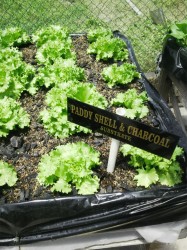
Ramsammy made an appeal to all to work together to ensure all farmers are registered. He said that the focus should be on becoming engaged in a formal agriculture sector, where Guyana will have traceability (the ability to track food from the farm to the shop) laws. He alluded to the fact that a traceability bill is at the Attorney General’s office, in effort to introduce those laws that will eliminate some of the export issues Guyana has. He also mentioned an Animal Welfare bill is also headed to the National Assembly to govern how animals are kept and slaughtered. He said that this is so because the Americas are putting rules in place. “This is a good time for us to address those issues,” he added.
He also said that agro-processing must become an integral part of the agriculture sector, which he argued could be the basis of a strong industrial base for the country as evidenced by the sugar and rice industries.
He also highlighted the continuing ‘Grow More Food’ campaign but asserted that it must be directed towards import reduction of produce that can be grown in Guyana and providing employment opportunity for Guyanese.
Meanwhile, CASRI country representative Roland Fletcher said that in keeping with CASRI’s primary objective, of developing self-reliance and economic independence among youth as well as financially and socially-challenged households, the organisation moved to develop a link with Partners of the Americas to launch the first phase of the project.



